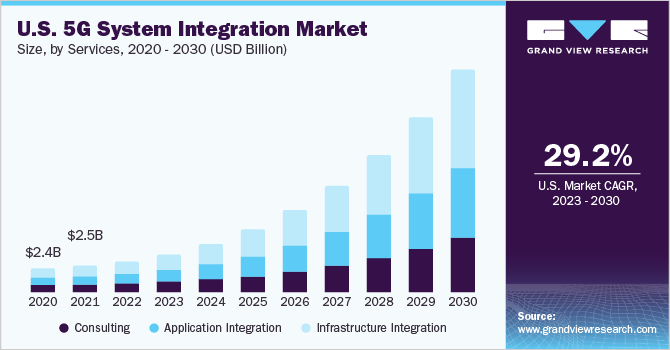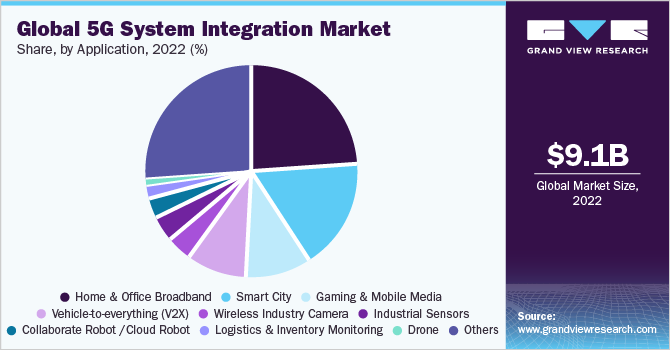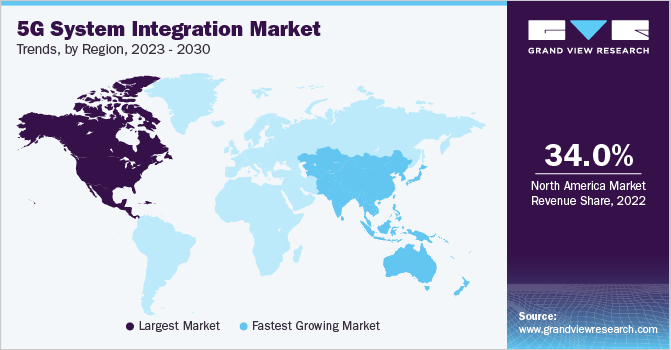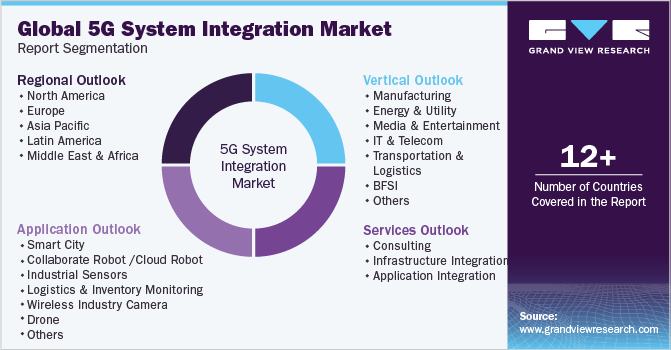- Home
- »
- Next Generation Technologies
- »
-
5G System Integration Market Size And Share Report, 2030GVR Report cover
![5G System Integration Market Size, Share & Trends Report]()
5G System Integration Market Size, Share & Trends Analysis Report By Services (Consulting, Application Integration), By Vertical (Manufacturing, Healthcare), By Application, By Region, and Segment Forecasts, 2023 - 2030
- Report ID: GVR-4-68038-149-8
- Number of Report Pages: 125
- Format: PDF, Horizon Databook
- Historical Range: 2019 - 2021
- Forecast Period: 2023 - 2030
- Industry: Technology
Report Overview
The global 5G system integration market size was estimated at USD 9.1 billion in 2022 and is anticipated to grow at a compound annual growth rate (CAGR) of 28.0% from 2023 to 2030. The increasing penetration of 5G networks globally is one of the major factors attributed to the growing demand for 5G system integration services. In addition, the growing penetration of 5G-supporting devices, including tablets, laptops, smartphones, routers, smart home devices, and many others, is expected to fuel the growth of the market. The market is also driven by the growing need for low-latency and high-reliable connectivity to support industrial internet of things (IIoT) applications such as industrial sensors, industrial cameras, and collaborative robots.

Major global manufacturers are seeking opportunities to speed up their operations by embracing modern digital technologies to empower the fourth industrial revolution (Industry 4.0). Technologies such as big data analytics, industrial wireless camera, the Internet of Things (IoT), and collaborative robots are enabling manufacturing facilities to take a giant leap toward smart and data-driven flexible operations. In January 2022, Verizon Communications Inc. and Atos SE, an information technology service and consulting company, unveiled a cutting-edge partnership aimed at enabling intelligent IoT solutions using private 5G multi-access edge computing for businesses, governments, and communities globally. The collaboration was aimed to revolutionize the use of predictive analytics by providing a 5G edge solution that empowers companies to mitigate risk, enhance operational efficiency, and increase revenue.
In addition, several manufacturers have developed and implemented these aforementioned technologies to compete in a highly competitive environment. Manufacturers need to integrate them with next-generation networks to provide unified communication to these 5G technologies, which also helps reduce the overall operational downtime and costs through delivering continuous connectivity and remote monitoring. Thus, the robust deployment of the industrial internet of things (IIoT), along with the increasing demand for 5G services to deliver unified connectivity, is expected to bolster the demand for 5G system integration services during the forecast period.
With the evolution of fifth-generation mobile network services, various enterprises globally are aggressively focusing on integrating their legacy network infrastructure with the new upcoming 5G technologies. These companies are integrating their existing on-premise applications and cloud networks with modern 5G technologies to work seamlessly over a centralized network. This integration process allows enterprises to access high bandwidth capacity with low latency for their operations, thereby increasing the total operational efficiency by reducing the overall response time to customers. Therefore, a significant rise in demand for fast broadband to reduce overall response time is expected to drive the market for 5G system integration from 2023 to 2030.
The growing popularity of Network Function Visualization (NFV) and Software-Defined Networking (SDN) across enterprises is also expected to be one of the major factors driving the market for 5G system integration. NFV allows enterprises to deploy several virtual machines and firewalls to lead an efficient economy of scale. On the other hand, SDN provides a smart network architecture that aims to reduce hardware constraints on the company premises.
SDN allows these companies to manage the use of their network behaviors efficiently through an Application Program Interface (API). Thus, the rapid adoption of NFV and SDN technologies to minimize overall network infrastructure costs is anticipated to further surge the market growth. However, a rapidly increasing large chunk of datasets over the cloud, coupled with increasing demand for cloud-based application integration, creates a major security concern among consumers, which may hinder the 5G system integration industry growth in the future.
COVID-19 Insights
The COVID-19 pandemic outbreak substantially impacted the overall 5G industry globally. A few countries such as the U.S., Spain, France, and the UK postponed the spectrum auctions to deliver 5G services initially. In addition, several telecom network providers such as Huawei Technologies Co. Ltd, Nokia Corporation, and Telefonaktiebolaget LM Ericsson, temporarily delayed the 5G network deployment for telecom operators globally in Q1 and Q2 of 2020. The delay in 5G network deployment had an adverse impact on the demand for 5G system integration services. Furthermore, several federal governments across key countries such as the U.S., the UK, Germany, and others released various economy boost packages and provided ease in lockdown facilities, and allowed enterprises to resume their operation with limited workforce capacity. This, in turn, is expected to augment the overall market growth from 2023 to 2030.
Services Insights
The infrastructure integration segment dominated the 5G system integration market with a revenue share of more than 39.0% in 2022. It is expected to register the fastest CAGR of 29.7% from 2023 to 2030. This is attributed to the surging demand for the integration of traditional network infrastructure with next-generation network infrastructure. Thus, integration of legacy infrastructure facilitates users to access the same hardware with enhanced features, thereby reducing the additional costs of hardware. In addition, the infrastructure system integration services consist of network integration, building management, and data center infrastructure management (DCIM).
The consulting segment is anticipated to grow at a significant CAGR during the forecast period. With the rapidly augmenting demand for 5G technologies, such as network equipment, business enterprises initially approach system integrators to build upgraded network architecture for their organizations. This architecture helps business enterprises to boost overall operational output in less time. Moreover, spiraling demand for multi-vendor cloud-based applications across enterprises is anticipated to augment the need for application integration services over the forecast period.
Vertical Insights
The IT and telecom segment held the largest market share in 2022 of more than 25.0% and is anticipated to register a considerable CAGR from 2023 to 2030. This is attributed to surging demand for 5G integration services across various IT and telecom companies to support new radio (NR) waves. A healthy rise in demand for integrating enterprise network infrastructure and data center network hardware is anticipated to witness significant growth in demand for 5G system integration services in the IT and telecom segment. Moreover, 5G network services are estimated to witness significant adoption across enterprises over the forecast period due to an increased focus on providing uniform connectivity during a virtual meeting to reduce the overall travel time of a specialist or consultant. Therefore, demand for 5G system integration services is estimated to witness a substantial rise in integrating an entire enterprise network to make it compatible with the next-generation network.
As digitalization is becoming popular in the manufacturing sector, production lines are being continuously automated to improve overall production efficiency. This has triggered the need for seamless wireless communication between industrial robots, actuators, sensors, and other devices mounted in manufacturing facilities. Thus, the manufacturing sector is estimated to exhibit the fastest CAGR of 30.8% over the forecast period owing to the growing requirement for system integration services to integrate the entire manufacturing facility with 5G carriers supporting the network.
Application Insights
The home and office broadband segment held the largest market share of more than 23.0% in 2022 and is expected to register a considerable CAGR from 2023 to 2030. This is attributed to the growing need for 5G system integration services to deliver initially enhanced Mobile Broadband (eMBB) connectivity to consumers and enterprises. Moreover, a remarkable increase in IoT devices across rapidly developing smart cities worldwide is expected to surge the demand for 5G system integration services to make these devices compatible with next-generation network services. This factor is anticipated to further boost the growth of the smart city application segment from 2023 to 2030.

The adoption of collaborative robots and connected sensors is witnessing a significant rise in industrial applications globally. This is expected to drive the demand for next-generation data services to establish seamless connectivity, which, in turn, is projected to fuel the segment growth over the forecast period. Furthermore, the intelligent power distribution systems segment is estimated to witness notable growth owing to a flawless communication set-up between smart grids to monitor and automate power distribution and storage operations.
Regional Insights
North America dominated the global market in 2022 with a revenue share of more than 34.0%. This is attributed to the presence of large IT and telecom players, such as IBM Corporation; Microsoft Corporation; and Cisco Systems, Inc. Moreover, rising investments in deploying 5G infrastructure by key market players, such as AT&T Inc. and Verizon Communications Inc., are expected to create a robust need to integrate overall infrastructure and applications across various verticals, such as IT and telecom, energy & utilities, and healthcare, to support 5G NR frequency bands. This factor is anticipated to boost the overall growth of the regional market.

Asia Pacific is expected to expand at the fastest CAGR of 29.5% during the forecast period. Prominent telecom operators such as China Mobile Limited, China Telecom Corporation Limited, KT Corporation, and SK Telecom Co., Ltd. are making significant investments in rolling out fifth-generation networks in China, Japan, and South Korea. Most of these investments are envisioned to focus on implementing next-generation infrastructure for various industry verticals, including transportation, energy and utility, healthcare, media and entertainment, and manufacturing. Thus, rapidly growing investments in installing 5G infrastructure across the above-mentioned countries are expected to create a significant opportunity for system integrators in the market in the forthcoming years. Furthermore, a rapid increase in the number of small and medium IT companies in emerging countries, such as China and India, is estimated to propel regional market growth.
Key Companies & Market Share Insights
The market is moderately fragmented due to the presence of several players operating in the market. Key players are focusing on making adequate investments in developing systems integration software, platforms, and other solutions to enhance their overall product portfolios. For instance, in February 2023, at the Mobile World Congress 2023, HCLTech, a prominent global technology company, introduced various advanced technology solutions for the 5G ecosystem. The company’s 5G system integration framework (5G SF) allows operators of private and public 5G to seamlessly integrate and deploy vital components of a future-ready network. With 5G SF, communication service providers, hyper scalers, enterprises, equipment, and chip manufacturers would benefit from significant operational efficiencies, seamless virtual functions onboarding, and enhanced user and network experiences.
Market players are aggressively focusing on building partnerships and agreements to gain a significant market share on a global scale. For instance, in October 2021, Accenture, Stellantis, and TIM Brazil collaborated on a private 5G network trial project at the Stellantis plant in Goiana, northeastern Brazil. Stellantis has enhanced its automotive manufacturing productivity, safety, and business agility since the network's introduction in July 2021. Some prominent players in the global 5G system integration market include:
-
Accenture Inc.
-
Cisco Systems, Inc.
-
Huawei Technologies Co., Ltd.
-
Infosys Limited
-
Tata Consultancy Services Limited
-
Wipro Limited
-
Radisys Corporation
-
IBM Corporation
-
Hewlett Packard Enterprise Development LP
-
Oracle Corporation
-
HCL Technologies Limited
-
Amdocs
-
Broadcom (CA Technologies)
-
Hansen Technologies
-
Samsung Electronics Co., Ltd.
-
Telefonaktiebolaget LM Ericsson
-
Keysight Technologies
-
Ribbon Communications
5G System Integration Market Report Scope
Report Attribute
Details
Market size value in 2023
USD 11.1 billion
Revenue forecast in 2030
USD 62.7 billion
Growth rate
CAGR of 28.0% from 2023 to 2030
Base year for estimation
2022
Historical data
2019 - 2021
Forecast period
2023 - 2030
Quantitative units
Revenue in USD million/billion and CAGR from 2023 to 2030
Report coverage
Revenue forecast, company ranking, competitive landscape, growth factors, and trends
Segments covered
Services, vertical, application, region
Regional scope
North America; Europe; Asia Pacific; Latin America; MEA
Country scope
U.S.; Canada; UK; Germany; France; Italy; Russia; China; Japan; India; South Korea; Mexico; Brazil; Kingdom of Saudi Arabia (KSA); South Africa
Key companies profiled
Accenture Inc.; Cisco Systems Inc.; Huawei Technologies Co., Ltd.; Infosys Limited; Tata Consultancy Services Limited; Wipro Limited; Radisys Corporation; IBM Corporation; Hewlett Packard Enterprise Development LP; Oracle Corporation; HCL Technologies Limited; Amdocs; Broadcom (CA Technologies); Hansen Technologies; Samsung Electronics Co., Ltd.; Telefonaktiebolaget LM; Ericsson; Keysight Technologies; Ribbon Communications
Customization scope
Free report customization (equivalent up to 8 analysts working days) with purchase. Addition or alteration to country, regional & segment scope.
Pricing and purchase options
Avail customized purchase options to meet your exact research needs. Explore purchase options
Global 5G System Integration Market Report Segmentation
This report forecasts revenue growth at the global, regional, and country levels and provides an analysis of the latest industry trends in each of the sub-segments from 2019 to 2030. For this study, Grand View Research has segmented the global 5G system integration market report based on services, vertical, application, and region:

-
Services Outlook (Revenue, USD Million, 2019 - 2030)
-
Consulting
-
Infrastructure Integration
-
Application Integration
-
-
Vertical Outlook (Revenue, USD Million, 2019 - 2030)
-
Manufacturing
-
Energy & Utility
-
Media & Entertainment
-
IT & Telecom
-
Transportation & Logistics
-
BFSI
-
Healthcare
-
Retail
-
Others
-
-
Application Outlook (Revenue, USD Million, 2019 - 2030)
-
Smart City
-
Collaborate Robot /Cloud Robot
-
Industrial Sensors
-
Logistics & Inventory Monitoring
-
Wireless Industry Camera
-
Drone
-
Home and Office Broadband
-
Vehicle-to-everything (V2X)
-
Gaming and Mobile Media
-
Remote Patient & Diagnosis Management
-
Intelligent Power Distribution Systems
-
P2P Transfers /mCommerce
-
Others
-
-
Regional Outlook (Revenue, USD Million, 2019 - 2030)
-
North America
-
U.S.
-
Canada
-
-
Europe
-
UK
-
Germany
-
France
-
Russia
-
Italy
-
-
Asia Pacific
-
China
-
India
-
Japan
-
South Korea
-
-
Latin America
-
Brazil
-
Mexico
-
-
MEA (Middle East & Africa)
-
Kingdom of Saudi Arabia
-
South Africa
-
-
Frequently Asked Questions About This Report
b. The global 5G system integration market size was estimated at USD 9.1 billion in 2022 and is expected to reach USD 11.1 billion in 2023.
b. The global 5G system integration market is expected to grow at a compound annual growth rate of 28.0% from 2023 to 2030 to reach USD 62.7 billion by 2030.
b. The infrastructure integration segment dominated the market for 5G system integration with a market share of more than 39.0% in 2022 and is expected to register the fastest CAGR from 2023 to 2030.
b. The IT and telecom vertical dominated the 5G system integration market with a revenue share of more than 25.0%% in 2022 and is anticipated to advance at a substantial CAGR from 2023 to 2030.
b. The home and office broadband application segment dominated the global 5G system integration market with a share of more than 23.0% in 2022 and is expected to register a considerable CAGR from 2023 to 2030.
Share this report with your colleague or friend.
![gvr icn]()
NEED A CUSTOM REPORT?
We can customize every report - free of charge - including purchasing stand-alone sections or country-level reports, as well as offer affordable discounts for start-ups & universities. Contact us now
![Certified Icon]()
We are GDPR and CCPA compliant! Your transaction & personal information is safe and secure. For more details, please read our privacy policy.
We are committed towards customer satisfaction, and quality service.
"The quality of research they have done for us has been excellent."





